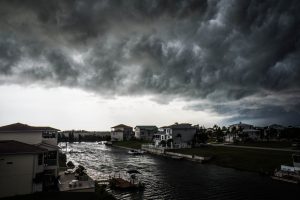In the first post of this series, we talked about gathering information. In this post, we are going to look at creating your plan.
Just as we mentioned in our previous blog, you should think about updating contact information and including out-of-town contacts when completing a family communication plan. Include your neighbors, as well. If you decide to evacuate, your neighbors might be able to provide a visual inspection of your home. Keep this information in your phone, but also in another location such as a small phone book.
Your plan should also include two meeting places. One should be outside of your home, for sudden events such as a fire. The second should be outside of your neighborhood, in case you are separated from family members and cannot get home.

If you decide to shelter in place, then consider these precautions:
- Secure windows and doors with hurricane impact protection and reinforce garage doors.
- Offer your home as a shelter to family and friends who live in a more vulnerable areas or a mobile home or RV.
- Check your disaster supplies ( we will discuss this in our next blog)
- Find a safe room in your home away from windows and skylights and glass doors. This room is usually in the interior of your home and can be a closet or bathroom on the lower level.
- If you lose power then turn off your major appliances such as your air conditioner, water heater, refrigerator, etc. to reduce damage from surge when your power is restored.
- Wait for official word that the danger is over and stay inside your home until you are told it is safe to venture out.
If you live in a mobile home or recreational vehicle (RV) or your dwelling was built prior to the 2002 building codes (and hasn’t been upgraded to those standards), or you are in an evacuation and/or flood zone, it is important that you leave.

Remember to allow yourself enough time to leave, don’t panic, and, most importantly, don’t risk your and your family’s lives by staying. Roads will be congested, so the sooner you leave the area, the less of a threat you will have of being caught on the highway without a safe refuge, running out of gas while stuck in traffic on the road, or running into the storm if it takes a different track than predicted or even running out of gas.
Here are some guidelines to follow if you are evacuating:
- Make sure your destination is not in a flood zone that has also been ordered to evacuate.
- Consider staying with a relative or friend’s home to shelter.
- Take enough supplies for you and your family (the focus of our next blog post).
- Remember to carry with you your important documents such as:
- Driver’s license
- Insurance policies and the agent’s contact information
- Property deeds and your property inventory
- Passports
- Special medical information, etc.
- Take irreplaceable items such as keepsakes and photos.
- Turn off your electricity, water and gas, if officials instruct you to do so.
- If you plan to shelter in a hotel or motel, consider calling well in advance for a reservation and to check if they accept pets, if needed. Again, make sure the destination is not in an evacuation zone. And, of course, communicate this plan with your family, friends and neighbors!
- Plan for your pets. Research your options for evacuating with your pet. Be sure all vaccinations are up to date. Many boarding facilities, hotels and evacuation centers will require proof of vaccinations.
If you need to evacuate to a shelter with your pet, you will need to take with you: proper ID collar and rabies tag, a carrier or large crate, food and water for two weeks, leash, indoor pee pads, and medications.
Consider microchipping and photographing your pet, in case you become separated.
RESOURCES
For more information on disaster planning visit the following resources:
- scgov.net/government/emergency-services/hurricane-preparedness
- floridadisaster.org
- tampabayprepares.org
- ready.gov
Other posts in this series:
- Gathering information (Are you ready?)
- Creating a plan
- Assembling your kit and supplies
- Evacuation shelters
- Post-disaster precautions
- Food safety
 0
0
